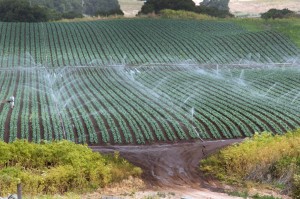20 April 2016
Asian irrigation influences East African rain
Posted by Lauren Lipuma
By Dörte de Graaf

Agricultural land in wet regions is irrigated to increase yields, such as with conventional sprinklers shown here. A new study finds irrigation from agriculture can directly influence climate thousands of kilometers away and even leap across continents.
Credit: USDA (CC BY 2.0)
Irrigation from agriculture can directly influence climate thousands of kilometers away and even leap across continents, new research finds. Up to 40 percent of the rain in some regions of East Africa can be attributed to irrigation used in agriculture in Asia, according to a new study published in Geophysical Research Letters, a journal of the American Geophysical Union.
Irrigation is often the only way to farm in dry regions, and agricultural land in wet regions is irrigated to increase yields. Irrigation technologies and methods vary depending on the prevailing climate, from the damming of water on surfaces, such as rice paddy fields, to the precise application of water through pipes and nozzles.
The sheer amount of water irrigation releases into the atmosphere suggests it has an influence on the climate globally, but few studies have investigated this impact beyond a local scale. In the new study, researchers at the Max Planck Institute for Meteorology in Hamburg, Germany used climate models to examine the global impact of irrigation-based agriculture in South Asia – home of the world´s largest amount of irrigation systems.
The researchers found irrigation can directly influence the climate in regions several thousand kilometers away by affecting the transport of water vapor in the atmosphere. Their study showed irrigation in Asia increases the amount of water vapor entering the atmosphere by transpiration from leaves and evaporation from the soil.
This increase in water vapor starts at the onset of spring in the Northern Hemisphere. During that time, low-level winds in the Arabian Sea flow in a southwesterly direction, transporting a large fraction of water vapor from South Asia to Africa´s east coast, according to the study authors. Between April and May, the winds turn: moisture transport from Asia stops and East Africa receives water vapor from the Middle East.
In dryer areas of East Africa, the increase in rain from South Asia and the Middle East corresponds to more than a third of the annual average rainfall, according to the new study. The authors also found irrigation weakens the Asian monsoon, which is responsible for a large amount of rain in Southeast Asia in the summer.
The study shows irrigation increases rain in some remote regions while decreasing it in others. These changes can also impact temperatures in remote regions: the increase in rain in East Africa leads to a surface cooling of up to 0.5 degrees Celsius (0.9 degrees Fahrenheit), according to the researchers. Weakening of the monsoon can reduce rainfall in Southeast Asia by as much as 2 millimeters (0.08 inches) per day and increase temperatures by 2 degrees Celsius (3.6 degrees Fahrenheit).
While the authors limited their study to Asia and Africa, their simulations suggest these effects can be found in other regions – irrigation in southern Europe may have an effect on climate in Western Europe and Scandinavia.
The amount of water used for irrigation is anticipated to increase by almost 50 percent until the year 2050, as irrigation-based agriculture is needed to meet the food demand of a growing world population, according to the authors. An increase or decline in irrigated areas due to increasing food demands or declining fresh water resources could also affect rain and temperatures in remote regions, they concluded.
—Dörte de Graaf is a communication assistant at the Max Planck Institute for Meteorology. This post originally appeared as a press release on the MPI website.


 GeoSpace is a blog on Earth and space science, managed by AGU’s Public Information staff. The blog features posts by AGU writers and guest contributors on all sorts of relevant science topics, but with a focus on new research and geo and space sciences-related stories that are currently in the news.
GeoSpace is a blog on Earth and space science, managed by AGU’s Public Information staff. The blog features posts by AGU writers and guest contributors on all sorts of relevant science topics, but with a focus on new research and geo and space sciences-related stories that are currently in the news.